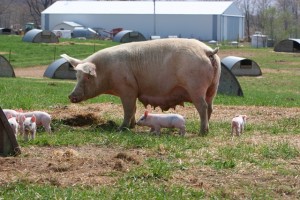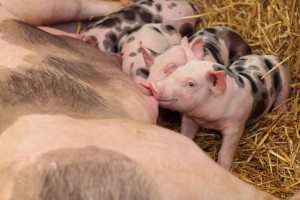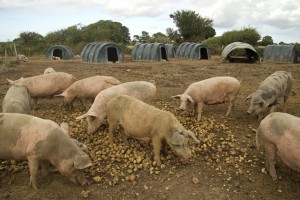Pig Diseases
Streptococcal Infections in Pigs
Including: Meningitis

Streptococcal suis is the fourth most significant pathogen in breeder and weaner systems in the US (Varela et al., 2013).
A variety of streptococcal infections affect pigs and can be associated with septicaemia, arthritis, meningitis and septic shock in both pigs and humans (Taylor, 1995). It is not clear why virulent S. suis strains successfully colonise only some piglets and not others. Some animals will merely be healthy carriers and will never develop disease, whereas others will, sooner or later, develop bacteraemia, septicaemia, meningitis or other clinical conditions (Haesebrouck et al., 2004). Environmental factors such as overcrowding, relative high humidity and excessive fluctuating temperatures can influence clinical disease (Dee et al., 1993).
It is a zoonotic disease. Human infection with S. suis occurs mainly among certain risk groups that have frequent exposure to pigs or pork (Halaby et al., 2000; Watkins et al., 2001). Outbreaks of human S. suis infection in the UK are uncommon, however, several outbreaks have occurred in China in recent years (Huang et al., 2005; Lun et al., 2007; Marois et al., 2007).
Streptococcal infection is caused by invasion of streptococci organisms through the respiratory route. The most common infection is from S. Suis Types 1 and 2 (Cowart, 1995; Higgins and Gottschalk, 2013; Taylor, 1995). Transmission is primarily from pig to pig, and from sow to piglet. In one report, 3.8% of weaned piglets were infected with Type 2 S. suis, and mortality from the disease accounted for 44% of mortality in weaned piglets over 2 years (Guise et al., 1985).

Suckling piglets are initially protected by maternal antibodies in their mother milk. It is more common 2-3 weeks post-weaning up to 4 months of age.
Disease is uncommon in sucking piglets as they tend to be protected by antibodies in colostrum. It is more common 2-3 weeks post-weaning period up to 4 months of age. S. suis Type 1 occurs fairly commonly in most countries and causes sporadic arthritis and occasionally meningitis in sucking piglets usually around one to two weeks of age but sometimes up to six weeks.
Streptococcal meningitis is another streptococcal infection that can lead to significant losses. In acute cases of Type 2 meningitis, weaners and growers may die. In the early stages shivering and lying flat with hair standing on end will be followed a few hours later by flicking eye movements with animals lying on their side paddling and salivating before the pig squeals with pain and goes into convulsion with the head laid on one side.
Nutrition is important as pigs that suffer nutritional stress can be more susceptible to disease. Low vitamin E in the diet may also exacerbate the incidence (Lamberts, 1997). PRRS infection can result in a greater susceptibility to S. suis infection (Feng et al., 2001; Thanawongnuwech et al., 2000). Therefore, strategies that reduce the risk of PPRS virus entering the herd or reduce the clinical signs of PPRS may reduce the clinical severity of S. suis.
Control and Prevention of Streptococcal Infections
The most likely source of entry into the farm are via replacement animals brought in. Some of the risks may be reduced by following particular sustainable livestock farming principles including:
- Maintaining a closed herd
- Low stocking rates
- A rotation policy, although it is important to bear in mind that the bacteria can survive at 0°C (32°F) in faeces for 104 days and in dust for 54 days, so it is probable it will survive for a similar duration outdoors in very cold conditions (Clifton-Hadley and Enright., 1984).
Excessive temperature fluctuation, high relative humidity, crowding, poor ventilation and an age spread of > 2 weeks between pigs in the same room have been identified as the 4 most commonly encountered problems on farms with higher-than-average percentages of carrier pigs (Dee et al., 1993).

The health of outdoor pigs tends to be better than of their indoor counterparts (Potter, 1998). Overcrowding, stress and poor ventilation are all regarded as contributors to risk of infection. Diseases where the transmission if from pig to pig is slower than in confined herds.
Huts and arks should be kept clean, dry and draught free, and used bedding destroyed. Accommodation should be insulated well in order to maintain stable temperatures and should be periodically disinfected (Band, 1990). Overcrowding, stress and poor ventilation are all regarded as contributors to risk of infection. Overall, low stocking rates will help to avoid overcrowding provided adequate hut space for growing and finishing stock.
Rodents, and flies have been associated with farms carrying high rates of S. suis (Varela et al., 2013).
Ideally, animals should only be purchased from herds that are accredited free of S. suis Type 2 and should be isolated on delivery for screening for symptoms (Cowart, 1995; Potter, 1998). Mixing of different age groups of pigs is seen as a contributing factor in indoor units (Higgins and Gottschalk, 2013). S. suis Type 2 can be spread by direct nose to nose contact and by aerosol infection in confined spaces. Clinically healthy pigs can be carriers. Once a serotype has entered a herd it becomes established in the tonsil as part of the normal flora and there are no techniques available to remove it.
Destocking will help to reduce the microbial load in an existing facility, followed by use of appropriate disinfectants and hot water (Dee et al., 1993). S. suis is quickly killed by disinfectants, including phenolic and chlorine and iodine based disinfectants (Band, 1990). Detergents and soaps are also effective.
Vaccination against Streptococcus suis
MSD Animal Health produce a vaccine called Porcilis Strep suis. This is available in Europe and requires an SIC (Special Import Certificate) for use in the UK. Autogenous vaccines can also be made in the UK. These are specific to the unit affected. In the US there are both commercial and Autogenous vaccines options.
Treating Streptococcal Infections
Early treatment, isolation and good nursing are all important in aiding recovery and minimizing suffering, as is the use of anti-inflammatory products alongside antimicrobials for improved recovery rates and response to treatment. They also relieve pain and discomfort caused by infection.
In treatment of clinical cases, penicillin is effective (Johnston et al., 1992; McKellar et al., 1987), together with isolation and the provision of adequate food and water. Pigs that are infected with S. suis Type 2 and are convulsing need to be watered carefully with a drench as they are unable to drink voluntarily. In most severe cases rectal administration of water given frequently in small volumes may be needed. Vitamin E supplements for piglets may also enhance resistance to the disease (Lamberts, 1997). Antibiotic resistance of S. suis to antimicrobials commonly used in swine, including lincosamides, macrolides, sulphonamides and tetracycline has been documented worldwide with resistance in up to 85% of strains (Varela et al., 2013).
For more on treatment see: http://www.thepigsite.com/pighealth/article/360/streptococcal-infections
Streptococcal Infections and Welfare
Affected animals should always be isolated and treated immediately to avoid suffering. Pigs affected with S. suis Type 2 should be kept in a quiet, dark environment, avoiding stimuli in order to limit the risk of convulsion. Care should be taken that convulsing animals are watered often enough to avoid dehydration. Severely affected cases that are non-responsive to treatment may require euthanasia on welfare grounds.
Good Practice Based on Current Knowledge
- A closed herd policy should be operated if possible
- Maintain high levels of hygiene in farrowing huts and arks
- Keep huts dry, well-ventilated and clean
- Burn or destroy used bedding
- Disinfect houses between batches
- Maintain low stocking rates, and minimise stress levels in weaner accommodation
- Isolate infected stock from the herd and treat immediately
- If replacement animals are purchased, ensure these come from herds accredited free of S. suis Type 2
- Treatment of infected animals should commence as soon as the disease is recognised
If streptococcal infections have been a problem in the unit in the past, design an action plan for outbreaks for the animal health plan, in collaboration with the vet.


 American English
American English

Comments are closed.